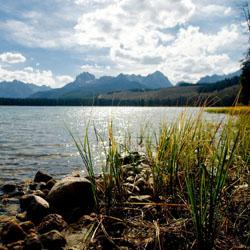Watershed Health Assessment Tools Investigating Fisheries
 Issue:
Issue:
The Mid-Atlantic Highland region of New York, New Jersey, Pennsylvania and Connecticut is a biologically diverse, economically active region of the Appalachian Mountains, where resource extraction and recreation coexist.
Aquatic ecosystem assessment and management tools are needed to help stakeholders assess the effects of sedimentation, stream temperature and other habitat stressors on streams throughout this area as well as other regions. Two-thirds of streams in this region are in fair to poor condition.
Tools are also necessary to evaluate management options — from natural stream channel designs and watershed best management practices to fisheries management. Additionally, tools are needed that can look at the region-wide status of aquatic resources and provide forecasting tools for evaluating restoration actions for management of stream communities, thresholds and landscape drivers.
Action:
EPA scientists collaborated with the Canaan Valley Institute, a nonprofit outreach organization in the Mid-Atlantic Highland region, to develop a suite of tools to address aquatic ecosystem assessment and management.
See: Canaan Valley Institute Exit
WHATIF is software that integrates a number of calculators, tools, and models for assessing the health of watersheds and streams with an emphasis on fish communities. The toolset consists of hydrologic and stream geometry calculators, a fish assemblage predictor, a fish habitat suitability calculator, macro-invertebrate biodiversity calculators, and a process-based model to predict biomass dynamics of stream biota — the Bioaccumulation and Aquatic System Simulator (known as the BASS model).
See: Bioaccumulation and Aquatic System Simulator (BASS)
The WHATIF toolkit assesses conditions and associated stressors in aquatic ecosystems, examines causes of impairment, and forecasts ecological outcomes of habitat alteration and fisheries management actions. WHATIF also supports screening analyses, such as prioritizing areas for restoration and comparing alternative watershed and habitat management scenarios.
Results and Impact:
WHATIF was initially developed to meet the needs of stakeholders in the Mid-Atlantic Highlands. It has since been extended to include estuarine habitats in the Gulf Coast region.
State stream assessment data has also been added to WHATIF, using a regional West Virginia dataset from the Environmental Monitoring and Assessment Program (EMAP). Additionally, because it is nationally flexible and extendible, datasets can be added to the WHATIF toolkit to create tools for new regions of the U.S.
See: Environmental Monitoring & Assessment Program in archive.epa.gov
Technical Contact:
John M. Johnston (Johnston.JohnM@epa.gov)
Related Links:
- Download WHATIF, Version 3.1
- Learn more about WHATIF
- Environmental Monitoring and Assessment Program (EMAP)
- Bioaccumulation and Aquatic System Simulator
- Classification of Functional Process Zones in Large Rivers
- Headwater Stream Research
